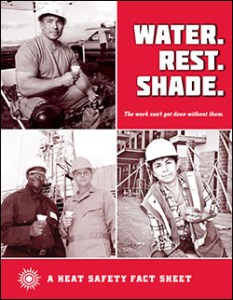
by Brianna Crandall — August 22, 2014—Facilities managers who oversee personnel performing such outdoor tasks as construction/upkeep, landscaping, and lawn or sports field maintenance during the hot summer months should take note of a new report issued by the Centers for Disease Control and Prevention (CDC) on the Occupational Safety and Health Administration’s (OSHA) review of 20 heat-related enforcement cases from 2012 to 2013. Companies with workers in hot indoor environments such as manufacturing or baking will also benefit from the information.
OSHA’s analysis, described in “Heat Illness and Death Among Workers — United States, 2012—2013” in the CDC’s Morbidity and Mortality Weekly Report, suggests that the primary risk factor for heat fatalities is the lack of acclimatization programs.
Of the 13 enforcement cases that involved worker fatalities, nine of the deaths occurred in the first three days of working on the job, with four of them occurring on the worker’s first day. In all 20 cases, heat illness prevention programs were found to be incomplete or absent, and no provision was made for acclimatizing new workers to the heat.
According to OSHA, acclimatization is a critical part of preventing heat illnesses and fatalities, and workers should gradually build up workloads and exposure to heat by taking frequent breaks for water and rest in shade or air conditioning.
OSHA’s national Campaign to Prevent Heat Illness in Workers, now in its fourth year, raises awareness among workers and employers about the risks for heat-related illness or death and provides tools to help prevent them. The agency’s review found that the core elements of its campaign, “Water. Rest. Shade.,” remain critical components of a comprehensive heat illness prevention program that can help save workers’ lives.
OSHA also recommends that employers have prevention programs that include oversight, hazard identification, a formal acclimatization program, modified work schedules as necessary, training, monitoring for signs and symptoms, and emergency planning to prevent heat-related fatalities.
OSHA has a free application for mobile devices that enables workers and supervisors to monitor the heat index at their work sites. The Heat Safety Tool app displays a risk level for workers based on the heat index, as well as reminders about protective measures that should be taken at that risk level. Since its 2011 launch, approximately 160,000 users have downloaded the app.
For more information and resources in English and Spanish, see OSHA’s Heat Stress site or its “Water. Rest. Shade.” campaign page. OSHA’s Occupational Heat Exposure topic page also covers workers in hot indoor environments.




